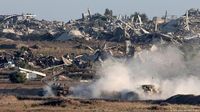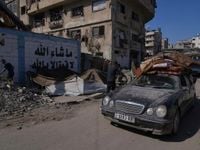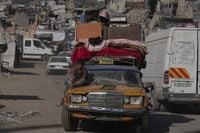On August 29, 2025, the Israeli military declared Gaza City a "combat zone" and launched the initial stages of a major offensive, marking a dramatic escalation in a conflict that has already left tens of thousands dead and displaced. The move came as Israel suspended daily humanitarian pauses that had allowed limited aid deliveries into the famine-stricken city, drawing sharp international condemnation and raising fears for the hundreds of thousands of civilians still trapped in the besieged enclave.
According to the Gaza Health Ministry, the death toll in Gaza soared past 63,000 on Friday, with 63,025 reported fatalities since the war began nearly two years ago. In the 24 hours preceding the announcement, hospitals in Gaza recorded 59 new deaths, underscoring the relentless pace of the violence. The ministry, which is part of the Hamas-run government but staffed by medical professionals, reported five additional deaths from malnutrition-related causes in the same period, bringing the total number of starvation deaths to 322, including 121 children. The United Nations and independent experts continue to cite the ministry’s figures as the most reliable, given Israel’s refusal to provide its own data or allow independent journalists unfettered access to the territory.
Israel’s military spokesperson, Avichay Adraee, announced on X (formerly Twitter), “We are not waiting. We have begun preliminary operations and the initial stages of the attack on Gaza City. We will intensify our strikes until we bring back all the kidnapped hostages and dismantle Hamas.” The Israeli military also called on residents to evacuate south, warning that leaving the city was now “inevitable.” Yet, for many, the options are grim. “We cannot find any place in the west nor in the south. Conditions are difficult. Where are we going? We don’t know,” resident Saddam Yazigi told The Associated Press as he prepared to leave.
The offensive comes after weeks of intensified bombardment on the city’s outskirts, particularly in the Zeitoun and Sabra neighborhoods, where Gaza’s Civil Defence estimates that more than 1,000 residential buildings have been flattened since early August. Plumes of smoke and thunderous blasts were visible from southern Israel on Friday morning, as the Israeli military ramped up its strikes. According to Al Jazeera, residents described relentless attacks from both the air and land, with some forced to flee repeatedly. Displaced resident Ahmed Moqat recounted, “Here’s the debris that fell last night next to my head. Now I will go out in the street, only God knows where I will go.”
International reaction to the offensive has been swift and critical. France, Britain, Canada, and Australia have all condemned the expansion of Israel’s campaign in Gaza City, urging restraint and a renewed focus on humanitarian aid. Meanwhile, inside Israel, tens of thousands of citizens have taken to the streets in recent weeks, demanding that Prime Minister Benjamin Netanyahu strike a deal with Hamas to secure the safe release of the remaining hostages. Hostage family members, who organized a nationwide strike on August 16, voiced deep concern that the renewed military push could endanger their loved ones. As Rubi Chen, whose son was abducted during the October 7, 2023 attack, put it, “At least they have closure. There are still 49 families waiting to have that closure.”
The fate of the hostages remains a central and agonizing issue. On Friday, Israel announced that its military had recovered the remains of two hostages, including Ilan Weiss, who was killed during the October 7 attack on Kibbutz Be’eri. Nearly 50 of the 251 hostages taken during that attack remain in Gaza, with about 20 believed to be alive. The Hostages and Missing Families Forum, which has organized large-scale protests, urged Israeli leaders to “enter negotiations and stay at the table until every last hostage comes home. Time is running out.”
While Israel argues that the offensive is necessary to cripple Hamas’ capabilities and prevent a repeat of the October 7 attack, humanitarian organizations warn that the consequences for civilians are catastrophic. Last week, the world’s leading food security authority, the Integrated Food Security Phase Classification (IPC), declared a famine in Gaza governorate, which includes Gaza City. UNICEF spokesperson Tess Ingram, visiting a nutrition center in the city, described a surge in malnourished children and a desperate shortage of therapeutic food. “It’s clear on the ground that famine is absolutely ravaging Gaza City,” Ingram told Al Jazeera. “But we just don’t have enough; the demand is really high, and supplies are low.” Health workers at the center are forced to ration fortified high-energy biscuits and therapeutic paste, as desperate parents bring in their children for screening and treatment.
The United Nations Office for the Coordination of Humanitarian Affairs (OCHA) warned that the renewed offensive could “have a horrific impact on people already exhausted, malnourished, bereaved, displaced, and deprived of basics needed for survival.” Zaher al-Wahidi, a spokesperson for Gaza’s Health Ministry, echoed these concerns, stating, “We cannot provide health services to 2 million people besieged in the south.” The UN also fears that the loss of hospital bed capacity in the north could be devastating, as the area is already suffering from a critical shortage of medical supplies and functioning health facilities.
Despite the mounting humanitarian crisis, aid groups say that delivering assistance remains a formidable challenge. The Norwegian Refugee Council, which coordinates a coalition of aid organizations in Gaza, reported having no advance notice of the resumed offensive. Blockades, looting, and Israeli restrictions have made it nearly impossible to get sufficient aid into the city, even during previous “tactical pauses.” According to the UN, 23,000 people had evacuated Gaza City in the week leading up to the new offensive, but for many, there is simply nowhere safe to go.
Some, like the 440 people sheltering at the Holy Family Church in Gaza City, have decided to stay, despite the risks. “When we feel danger, people get closer to the walls or whatever, it’s more protected,” Farid Jubran told The Associated Press. The UN’s humanitarian agency and many NGOs have also pledged to keep their staff on the ground, determined to assist those who remain.
As the war in Gaza nears the end of its second year, the stakes for civilians, hostages, and the region’s fragile future could hardly be higher. The world watches, many in horror, as the cycle of violence, displacement, and deprivation grinds on, with no clear end in sight.



